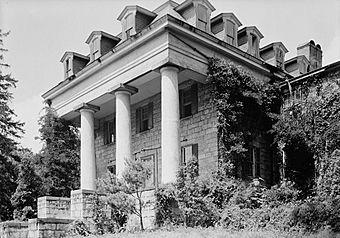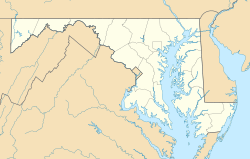Patapsco Female Institute facts for kids
Quick facts for kids |
|
|
Patapsco Female Institute
|
|
|
U.S. Historic district
Contributing property |
|

Patapsco Female Institute in 1936
|
|
| Location | Ellicott City, Maryland |
|---|---|
| Area | , |
| Built | ca. 1837 |
| Architectural style | Greek Revival |
| NRHP reference No. | 78001467 |
| Added to NRHP | July 31, 1978 |
The Patapsco Female Institute (PFI) was once a special boarding school for girls. It is located on Church Road in Ellicott City, Maryland, United States. Today, it is a historic site that has been partly rebuilt. The area around the old school is now famous for outdoor plays put on by The Chesapeake Shakespeare Company. In the 1930s, the Institute was also known as "Warwick."
Contents
A Look Back: The School's History
The Phelps Years
The Patapsco Female Institute officially started in January 1834. It was designed by an architect named Robert Cary Long, Jr.. Charles Timanus, who also built the Court House, constructed the building. The school opened its doors on January 1, 1837.
At first, it was a "finishing school" for girls. But under the leadership of Almira Hart Lincoln Phelps, it became a place where young women could train to become teachers. This helped them support themselves. The school stayed open until 1891. Students were usually between 12 and 18 years old. At its busiest, about 150 students attended the Institute.
In 1840, the schools in Ellicott Mills (now Ellicott City) were not doing well. Bishop William R. Whittingham, a church leader, became involved. He personally chose Almira Hart Lincoln Phelps to be the principal of PFI. She and her husband, John Phelps, leased the school for seven years. John Phelps managed the business side, like money and building upkeep.
Students paid a basic fee for their room, food, laundry, and English lessons. Extra classes like foreign languages, music, and dance cost more. The school also got money from state-approved lotteries. It received $800 each year to help poorer students who wanted to become teachers. This state payment stopped in 1860.
The school year had two 22-week terms, starting in May and November. Diplomas were given out in April and October. Usually, five or six girls earned their diplomas each term. Students could also get certificates for finishing specific subjects, like English.
Almira Hart Lincoln Phelps worked hard to help her students find jobs. She often found teaching positions for them. Sometimes, after gaining experience, a girl would return to PFI to finish her studies.
When school was not in session, Almira Hart Lincoln Phelps would leave town to visit family or publishers. John Phelps would stay behind to keep the school open. He also made sure the buildings were cleaned and repaired.
Mrs. Phelps had to have a church chaplain on staff. The first chaplain was Rev. Holmead. After 1856, the chaplains were usually the rectors (head priests) of the local church, St. Peter's.
The Phelpses signed a second seven-year lease in 1848. John Phelps passed away in 1849. In 1855, Almira Hart Lincoln Phelps decided not to renew her lease. She stayed one extra year to help the school expand. This made it big enough for students from the school run by her replacement, Robert Harris Archer.
The Archer Years
Robert Harris Archer (1812 - 1875) took over the PFI in 1856. He was a graduate of West Point, a famous military academy. Mr. Archer had run girls' schools in Baltimore before.
The PFI changed under Mr. Archer. The school became larger, and fees were higher. Girls had more freedom to move around. Also, more students stayed at the school when classes were not in session. Mr. Archer had programs for the girls all year. For example, he was seen with students at a spa in Virginia in July 1857.
The students came from different places. Almira Hart Lincoln Phelps had students from Maryland, Virginia, and states north of Maryland. Mr. Archer had many students from the Southern states because of his family connections. His students stayed at the school for more years, from 1856 to 1877. They made a bigger impact on the local community than Mrs. Phelps's students.
The Civil War (1861-1865) was very tough for the PFI and Mr. Archer's money. In 1866, he wrote that the war almost ruined him. He was owed $30,000 by parents of students from the Southern states. The school closed for a time in 1861 due to riots in Baltimore. It closed again in 1862 when soldiers camped near the school. The school reopened in the spring of 1863.
Mr. Archer became too ill to run the school by 1871. On July 10, 1871, the PFI board decided to let his wife, Mary Ringgold Archer, take over the lease. Mrs. Archer ran the school with Roberta Archer, Robert Archer's daughter. They managed the school until the lease ended in 1877. Mary and Roberta Archer then moved their school to Washington, D.C., calling it the Archer Institute.
The School's Final Years
The PFI stayed closed for a year while $10,000 was spent on improving the building. It reopened in the fall of 1879. Sarah N. Randolph (1839 - 1892) ran the school. After her seven-year lease ended in 1885, she moved to Baltimore and opened a school there.
In September 1885, an advertisement showed Annie Matchett as Principal and Roberta Archer as Vice Principal of PFI. However, their lease ended early. Amanda Taylor became Principal by the 1886-1887 school year. She struggled to make enough money, and the school closed. In 1891, the company that owned the school was shut down, and the property was sold to James E. Tyson.
What Happened Next
The property was turned into a summer hotel called the Burg Alnwick Hotel. Fourteen years later, in 1905, Miss Lilly Tyson bought it and made it her private home. In 1917, during the First World War, the building was used as a hospital. It had 50 beds for wounded soldiers returning home. Later, the building was used as a theater and then as a private home again.
In 1938, the local school board thought about using the site for a new school. Guests at the Burg Alnwick Hotel used the grounds for shooting clay pigeons. In 1958, the property was sold to Dr. Whisman, who used it as a nursing home. To prevent fires, Howard County asked the owner to remove all wood from the building, including the roof, floors, and walls. This left the Institute in ruins. Dr. Whisman left the property to his old college, the University of Cincinnati.
In 1966, Howard County bought the eight-acre property from the University of Cincinnati for $17,500. Since then, a group called 'Friends of the Patapsco Institute' has taken care of the building. They have made it stable and partly restored it. The grounds are now fenced to limit public access. Even though the county finance director said the building could not be fully restored, $1.7 million was set aside to turn the area around it into a park.
There is a popular rumor that the Patapsco Female Institute is haunted by the ghost of a young woman named Annie Van Derlot. People say she died of pneumonia while attending school there. While this story is popular with ghost hunters, there is no record of anyone named Annie Van Derlot ever being a student at the Institute.



